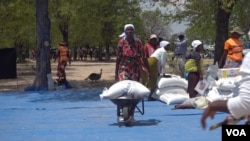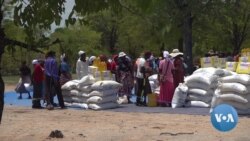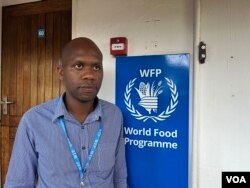President Emmerson Mnangagwa's government says Zimbabwe is now food secure and will not import food until next year. As The government claims are in sharp contrast to aid organizations saying that millions are food insecure.
Zimbabwe has been known for years to rely on international aid agencies for food relief, but that is now changing according to Monica Mutsvangwa, the information minister.
She said about 544,000 metric tons of food, comprising 467,000 metric tons of maize and 77,000 metric tons of traditional grains had been delivered by farmers to the country’s Grain Marketing Board (GMB) which buys harvested crops in Zimbabwe.
“The available grain will last for 11 months at a consumption rate of 49,295 metric tons per month. Wheat stocks at GMB stand at 179,218 metric tons, and this will provide 8.5 months’ cover at a consumption rate of 21 000 metric tons per month,” she said.
The harvest of Zimbabwe’s staple crops starts in March 2023, while wheat is harvested later in September and October. But it is mainly corn that many Zimbabweans rely on for their staple food called sadza or isitshwala — a thick porridge covered in relish before being eaten.
The U.N. World Food Program in Zimbabwe says with funding from the USAID, it is importing corn from neighboring Zambia to some rural districts.
On Wednesday, it said it would not stop its program for food insecure people until their next harvest.
“This is a positive development. However, food availability does not equity to food security since not every Zimbabwe has access or can afford grain," said Tatenda Macheka from the WFP in Zimbabwe, commenting on Mutsvangwa’s announcement. "The rural Zimvac estimates that 3.8 million people will be cereal insecure at the peak of the lean season. WFP has been providing food assistance since the start of the lean season in October and continuous work with the government to assist those in need. At peak WFP will reach 700 000 people with food assistance while the government will support 3.1 million with cereal.”
Recently, the government released the Zimbabwe Vulnerability Assessment Committee or ZimVAC, which confirmed the figures Macheka talks about.
However, the government is projecting optimism and talking about making Zimbabwe food secure.
“Cabinet would like to highlight the following areas planted for the major crops this year compared to same time of the previous season: Maize, 465 707 hectares compared to 215 481 hectares; when it comes to soyabeans, 7 578 hectares compared to 8 948 hectares; when it comes to sorghum, 59 481 hectares against 12 210 hectares; when it comes to cotton, 88 856 hectares compared to 13 166 hectares; and finally, tobacco, 75,758 hectares versus 64,155 hectares planted last year,” said Mutsvangwa.
Zimbabwe, once the breadbasket of the region, has been an economic basket case for more than 20 years now. The government attributes that mainly to drought and western sanctions, while critics say it is because experienced commercial farmers were pushed off their land and replaced with peasant farmers starting in 2000.
It seems the government believes the good old days in Zimbabwe are set to return.











